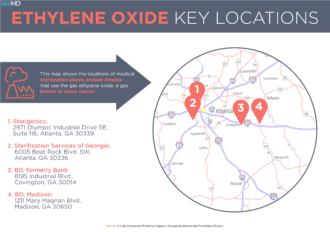Brenda Goodman is a senior news writer for WebMD. Andy Miller is editor and CEO of Georgia Health News.
A medical supply sterilizing facility east of Atlanta that is under scrutiny for toxic emissions had an eight-day leak last month of ethylene oxide, a cancer-causing substance.

The City of Covington on Wednesday released a report on the September ethylene oxide leak at the BD facility, which the company said was about 7 pounds per day, or 54 pounds in all.
State regulations do not require sterilizing companies to report leaks of less than 10 pounds per day, but BD notified Georgia’s Environmental Protection Division (EPD).
The EPD said Wednesday that it’s investigating the BD leak.
The state agency Thursday announced results of another ethylene oxide leak investigation – a July incident at a different metro Atlanta sterilizing plant, run by Sterigenics.
The Sterigenics facility, in Smyrna, just northwest of Atlanta, has had several unreported releases of the chemical in the past five years, EPD said. Each was less than 10 pounds, Sterigenics said in an email to an EPD official.
Details of the BD leak
The BD leak from an improperly closed roof valve occurred during part of the time the city was testing the air around the plant to determine the level of emissions of ethylene oxide, a Covington official said.
Local politicians and community leaders had called for the independent air testing amid concerns about cancer risks from ethylene oxide in the Covington area, about a half-hour east of Atlanta.
A July report from WebMD and Georgia Health News identified three metro Atlanta census tracts in EPA data as having an elevated cancer risk from air pollution, largely driven by ethylene oxide. Two of the tracts are in Fulton County, near the Sterigenics facility. The third is in Covington.
The EPA classified the chemical as a cancer-causing substance in 2016.

Michael Dourson of Toxicology Excellence for Risk Assessment, a company that has contracted with BD, said the 54 pounds over eight days “is of no concern to me from a cancer point of view.”
“It would have to be a lot larger [release] for us to be worried,’’ he said.
But Ron Sahu, an environmental engineer and consultant to the Southern Environmental Law Center, said the BD leak total of 54 pounds “is a substantial amount because the compound is a carcinogen.”
The 10-pound daily leak threshold that mandates reporting to regulators “isn’t based on risk to health,” Sahu said. Being under 10 pounds a day doesn’t mean it was safe, he added.
Sahu said it’s a weakness of the permit and regulatory climate in Georgia that companies are allowed to release this much ethylene oxide with no legal penalties.
The announcement of the BD leak came the same day that the company invited reporters to tour its Covington facility, which sterilizes millions of medical devices annually.

On Sept. 23, company officials discovered that a vacuum exhaust valve for one of the plant’s sterilizing units was not fully closed.
BD said the estimate of ethylene oxide released is “believed to represent worst case.’’
The company Thursday said a testing firm has determined that the emissions technology used at the Covington facility destroys 99.999% of ethylene oxide used during the sterilization process.
“The results of the latest stack test confirm that we operate our facility in a safe and responsible way, with newer, more sophisticated technology confirming that our stack emissions are extremely low,” Ellen Kondracki, vice president of Environment, Health and Safety at BD, said in a statement.
The Covington plant also suffered a leak of up to 85 pounds of ethylene oxide in January 2016. The leak was caused by the failure of a gasket. The company replaced the faulty gasket, and other connections within the system were also inspected, a state report said. The company said no injuries occurred in that incident.
State seeks data going back years
The EPD investigation of the July leak at the Sterigenics plant in Smyrna came after the AJC raised questions about the previously unreported accident. The amount of the ethylene oxide leaked was less than 6 pounds, Sterigenics said in August.

The state agency said in its report that because the ethylene oxide release in July was from “a spent drum,’’ Sterigenics was able to determine the leak was less than 10 pounds.
The EPD also requested data on other leaks over a 5-year period. The company had three releases in 2015, two in 2017, three in 2018, and one other this year, in April, according to a Sterigenics email. Each was less than 10 pounds, the company told the EPD.
“Going forward, EPD has requested that the facility send us monthly reports of all known releases, including those below the reportable quantity threshold,’’ the agency said in its report. “The facility has agreed to do so.’’
Tony Adams of Stop Sterigenics – Georgia said his group is suspicious of the emission figures provided by the company. “We don’t trust self-reported numbers,’’ Adams said. “We’re going to push for more oversight.’’
Sterigenics said in a statement Thursday that the state investigation’s findings “reaffirm our consistent compliance with applicable rules.”
“Sterigenics has always operated with a focus on safety and is committed to completing the voluntary enhancements at our Atlanta facility to further reduce ethylene oxide emissions below already safe levels,” the statement said. “With the installation of those enhancements nearing completion, we continue to work with state and local officials to resume sterilization operations in order to provide vital, sterilized medical products and devices to the patients and hospitals that depend on them.”
The Sterigenics facility is currently closed, pending a safety review by Cobb County officials.

